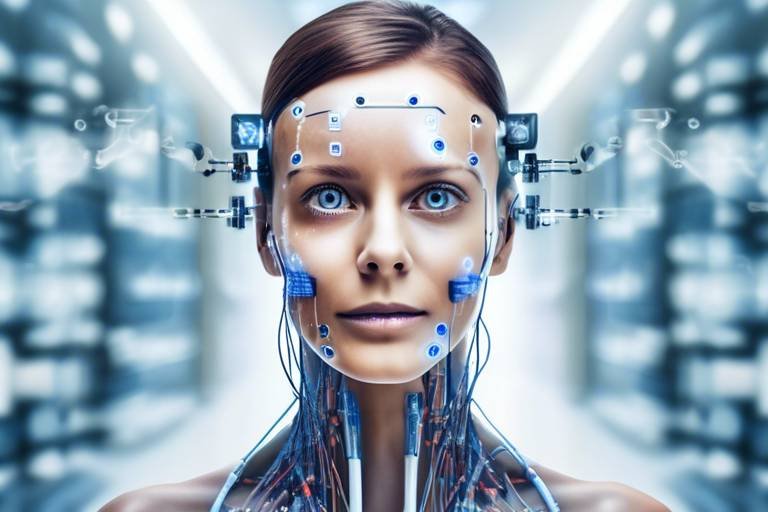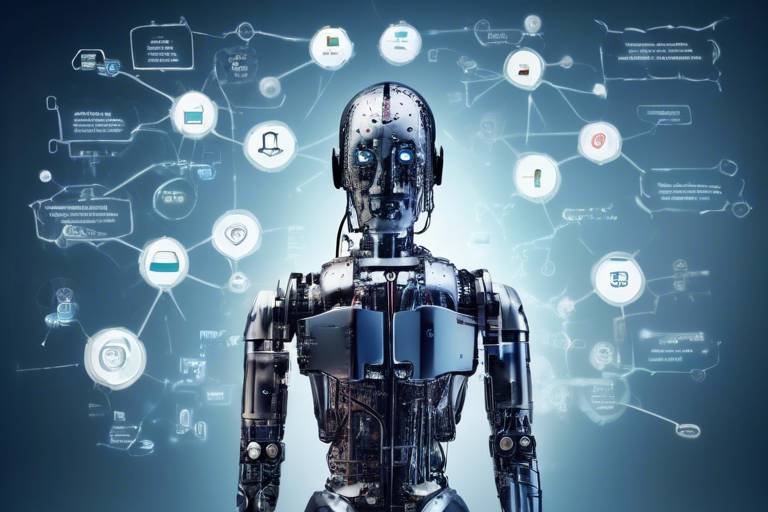AI and Big Data: A Revolution in Technology
The world as we know it is undergoing a seismic shift, thanks to artificial intelligence (AI) and big data. These two technological powerhouses are not just buzzwords; they are the driving forces behind a revolution that is reshaping industries, economies, and even our daily lives. Imagine a world where machines learn from their experiences, making decisions faster than any human could, or where vast oceans of data are transformed into actionable insights that propel businesses forward. This is not science fiction; this is the reality we are stepping into.
AI technologies, such as machine learning and natural language processing, have made significant strides in recent years. These advancements are enabling businesses to automate processes, enhance customer experiences, and make data-driven decisions that were once unimaginable. For instance, consider how virtual assistants like Siri and Alexa have evolved from simple command-response systems to sophisticated AI that understands context and can engage in meaningful conversations. This transformation is not just a technological marvel; it's a fundamental change in how we interact with machines.
On the other hand, big data has emerged as the new oil of the digital age. Just as oil fueled the industrial revolution, big data is now powering the information age. Organizations are harnessing vast amounts of data generated from various sources, including social media, IoT devices, and online transactions. This data is invaluable, providing insights that drive decision-making and enable personalized customer experiences. In fact, businesses that effectively leverage big data can gain a competitive edge, offering tailored services and products that resonate with their audience.
However, this revolution is not without its challenges. As organizations dive deeper into the world of AI and big data, they must navigate a complex landscape filled with ethical considerations, regulatory requirements, and technical hurdles. For example, how can companies ensure that their AI systems are free from bias? How can they maintain transparency in their data collection practices? These questions are critical as we forge ahead into this uncharted territory.
As we explore the transformative impact of AI and big data, it becomes clear that we are just scratching the surface of what is possible. The future holds immense potential for innovation, with emerging trends such as the integration of AI and IoT, which promises to revolutionize data analysis and automation across various sectors. The convergence of these technologies will unlock new opportunities, allowing businesses to operate more efficiently and respond to market changes in real-time.
In conclusion, the revolution brought about by AI and big data is not merely a technological advancement; it is a profound shift in how we understand and interact with the world around us. As we continue to navigate this landscape, it is essential to remain vigilant about the ethical implications and strive for responsible technology deployment. The journey ahead is full of surprises and explosions of innovation, and it's up to us to harness this power for the greater good.
- What is the difference between AI and big data?
AI refers to the simulation of human intelligence in machines, while big data pertains to the vast amounts of data collected and analyzed to derive insights. - How is big data collected?
Big data can be collected through various methods, including web scraping, IoT devices, and social media analytics. - What are the ethical concerns surrounding AI and big data?
Ethical concerns include issues of bias, transparency, accountability, and privacy in data handling. - What are the future trends in AI and big data?
Emerging trends include the integration of AI with IoT, advancements in predictive analytics, and increased focus on ethical AI practices.

The Rise of AI Technologies
Artificial Intelligence (AI) is no longer a concept confined to the realms of science fiction; it has rapidly evolved into a transformative force that is reshaping industries and our daily lives. The advancements in AI technologies, particularly in machine learning and natural language processing, have opened up new avenues for businesses, enabling them to harness data like never before. Imagine a world where machines can learn from data, adapt over time, and even understand human language—this is the reality we are stepping into.
Machine learning, a subset of AI, allows systems to learn and improve from experience without being explicitly programmed. This technology is behind some of the most significant innovations today, such as recommendation systems that suggest what to watch next on streaming platforms or what products to purchase online. These systems analyze vast amounts of data to identify patterns and make predictions, which can significantly enhance user experience and drive sales.
On the other hand, natural language processing (NLP) is revolutionizing how we interact with technology. With NLP, computers can understand, interpret, and respond to human language in a way that feels natural. Think about virtual assistants like Siri or Alexa; they can comprehend your requests and provide relevant information almost instantaneously. The implications for businesses are immense, as companies can now automate customer service, analyze consumer sentiment, and even generate content—all thanks to these advanced AI technologies.
However, the rise of AI technologies also comes with its own set of challenges. As businesses rush to integrate AI into their operations, they must also consider the ethical implications and the potential for bias in AI algorithms. For instance, if an AI system is trained on biased data, it can produce skewed results that may impact decision-making processes. Therefore, organizations must prioritize the development of fair and transparent AI systems to ensure that the benefits of this technology are accessible to all.
Furthermore, the rapid pace of AI development raises questions about the future workforce. As machines take over more tasks, there is a growing concern about job displacement. However, it's essential to view this transition as an opportunity for workforce reskilling. The demand for AI specialists, data scientists, and machine learning engineers is skyrocketing, creating new job opportunities that require a different skill set. Companies that invest in training their employees to work alongside AI technologies will likely thrive in this new landscape.
In summary, the rise of AI technologies is not just a trend; it is a revolution that is reshaping our world. From enhancing customer experiences to creating new job roles, the implications are vast and varied. As we embrace this change, it is crucial to navigate the challenges with a focus on ethics and workforce development. The question now is, how will your organization adapt to this rapidly evolving technological landscape?
- What is machine learning? - Machine learning is a subset of AI that enables systems to learn from data and improve their performance over time without being explicitly programmed.
- How does natural language processing work? - Natural language processing allows computers to understand and interpret human language, enabling applications like virtual assistants and automated customer service.
- What are the ethical concerns surrounding AI? - Ethical concerns include bias in AI algorithms, privacy issues, and the potential for job displacement due to automation.
- What skills are needed for jobs in AI? - Skills in data analysis, programming, and a strong understanding of machine learning principles are essential for careers in AI.

Big Data: The New Oil
In today's fast-paced digital landscape, big data has emerged as a transformative force, often likened to the oil of the 21st century. Just as oil fueled the industrial revolution, big data is now powering a new era of innovation and efficiency across various sectors. Organizations are increasingly recognizing that the ability to harness vast amounts of data can lead to more informed decision-making, enhanced customer experiences, and ultimately, a significant competitive advantage. So, what exactly makes big data so valuable?
At its core, big data refers to the enormous volumes of structured and unstructured data generated every second. This data comes from a multitude of sources, including social media interactions, online transactions, sensor data from IoT devices, and more. The sheer scale of this information can be overwhelming, but when analyzed effectively, it reveals patterns and insights that can transform businesses. For instance, companies can use big data analytics to understand consumer behavior, predict market trends, and tailor their offerings to meet customer needs more precisely.
One of the most compelling aspects of big data is its ability to drive personalization. In an age where consumers expect tailored experiences, organizations that leverage big data can create highly personalized marketing strategies. By analyzing customer preferences and behaviors, businesses can deliver targeted advertisements, recommend products, and enhance customer engagement. This level of personalization not only improves customer satisfaction but also fosters brand loyalty, as consumers feel understood and valued.
However, the journey to effectively utilizing big data isn't without its challenges. Organizations must invest in the right technologies and infrastructure to collect, store, and analyze data. They also need skilled professionals who can interpret complex data sets and derive actionable insights. Without this expertise, the potential of big data can remain untapped, leaving businesses at a disadvantage in a data-driven world.
To illustrate the impact of big data across different industries, consider the following table:
| Industry | Application of Big Data |
|---|---|
| Healthcare | Predictive analytics for patient outcomes and personalized treatment plans. |
| Retail | Customer behavior analysis to optimize inventory and enhance shopping experiences. |
| Finance | Fraud detection and risk management through real-time data analysis. |
| Transportation | Route optimization and predictive maintenance using real-time traffic data. |
As we delve deeper into the world of big data, it’s essential to recognize that its value is not just in the volume of data collected, but also in the insights derived from it. Organizations that can effectively analyze and interpret their data stand to gain a significant edge over their competitors. They can make proactive decisions rather than reactive ones, ultimately leading to increased efficiency and profitability.
In conclusion, big data is indeed the new oil, fueling innovation and shaping the future of industries. As organizations continue to explore the depths of data analytics, they will uncover new opportunities and strategies that can revolutionize their operations and drive growth. The question remains: Are you ready to tap into the potential of big data?
- What is big data? Big data refers to the large volumes of data generated from various sources that can be analyzed for insights and decision-making.
- Why is big data important? It allows organizations to make informed decisions, enhance customer experiences, and gain a competitive edge.
- What are some common applications of big data? Common applications include predictive analytics, personalized marketing, fraud detection, and operational efficiency improvements.
- What challenges do organizations face with big data? Challenges include data quality issues, privacy concerns, and the need for skilled professionals to analyze the data.

Data Collection Methods
In the age of information, the methods we use to collect big data have become as essential as the data itself. Organizations are leveraging a variety of techniques to gather insights that drive their decision-making processes. Imagine a treasure hunt where the treasures are insights hidden within vast oceans of data! The tools and methods of collection are the maps that guide us to these treasures.
One of the most prevalent techniques is web scraping. This method involves extracting data from websites, allowing organizations to gather information from various online sources. Think of it as a digital net cast over the internet, capturing valuable information effortlessly. With the right tools, businesses can monitor competitors, track market trends, or even gather customer feedback, all from the comfort of their screens.
Another significant player in the data collection arena is the Internet of Things (IoT). IoT devices, such as smart home gadgets and wearable technology, continuously generate data about user behavior and preferences. This data is a goldmine for organizations aiming to tailor their services to meet customer needs. For example, a fitness tracker not only monitors your health metrics but also collects data that can help companies design better health-related products.
Social media analytics is yet another innovative method of data collection. Platforms like Facebook, Twitter, and Instagram are not just places for social interaction; they are rich sources of data. Organizations can analyze user interactions, sentiment, and trends to understand their audience better. This method is akin to eavesdropping on a conversation to gain insights, but in a way that respects user privacy and consent.
However, while these methods are powerful, they come with their own sets of challenges. Organizations must navigate the complex landscape of data privacy and regulatory compliance. The balance between collecting valuable data and respecting individual privacy rights is a tightrope walk that requires careful consideration.
In summary, the methods of data collection are as diverse as the data itself. From web scraping to IoT devices and social media analytics, each technique offers unique advantages and challenges. As we continue to explore the vast world of big data, understanding these methods will be crucial for organizations aiming to harness its full potential.
- What is web scraping? Web scraping is the automated process of extracting data from websites, allowing businesses to gather information quickly and efficiently.
- How does IoT contribute to data collection? IoT devices collect real-time data about user behavior and preferences, which organizations can analyze to improve their products and services.
- Why is social media analytics important? Social media analytics helps organizations understand audience sentiment and trends, enabling them to tailor their marketing strategies effectively.
- What are the challenges of data collection? Organizations face challenges such as data privacy concerns, regulatory compliance, and ensuring data quality during the collection process.

Challenges in Data Collection
In the world of big data, data collection is the first crucial step in harnessing valuable insights. However, this process is not without its challenges. Organizations often find themselves navigating a complex landscape filled with obstacles that can impede their data collection efforts. One major hurdle is the issue of privacy concerns. With increasing awareness among consumers about data privacy, companies must tread carefully to ensure they are compliant with regulations such as GDPR and CCPA. This means that organizations need to be transparent about how they collect, store, and use data, which can complicate the data collection process.
Another significant challenge is data quality issues. Poor data quality can lead to inaccurate insights, which can have serious consequences for decision-making. For instance, if a company collects data from unreliable sources or fails to clean and validate its data, it risks making decisions based on flawed information. This not only wastes resources but can also damage a company's reputation. To combat this, organizations must invest in robust data management practices and tools to ensure the integrity of their data.
Furthermore, regulatory compliance adds another layer of complexity. Different regions have varying laws governing data collection and usage, which can create confusion for global organizations. Companies must stay updated on these regulations and adapt their data collection methods accordingly. This often requires additional resources and expertise, which can be a burden for smaller businesses.
In addition to these challenges, the sheer volume of data generated today can be overwhelming. The rapid pace at which data is created—through social media, IoT devices, and other sources—means that organizations need advanced tools and technologies to keep up. Without the right infrastructure, collecting and processing this data can become a daunting task.
To illustrate the impact of these challenges, consider the following table that outlines some common obstacles in data collection:
| Challenge | Description |
|---|---|
| Privacy Concerns | Consumers are increasingly aware of how their data is used, leading to stricter regulations. |
| Data Quality Issues | Poor data can lead to inaccurate insights, affecting decision-making and strategy. |
| Regulatory Compliance | Different regions have varying laws, complicating data collection for global organizations. |
| Volume of Data | The sheer amount of data generated daily can overwhelm existing systems and processes. |
Ultimately, while the challenges in data collection are significant, they are not insurmountable. Organizations that proactively address these issues through strategic planning, investment in technology, and a commitment to ethical data practices will be better positioned to leverage the power of big data for their advantage.
- What are the main challenges in data collection? The main challenges include privacy concerns, data quality issues, regulatory compliance, and the sheer volume of data generated.
- How can organizations ensure data quality? Organizations can ensure data quality by investing in data management tools, validating data sources, and implementing regular data cleaning processes.
- What regulations should companies be aware of? Companies should be aware of regulations such as GDPR in Europe and CCPA in California, which govern data privacy and protection.
- How can organizations overcome data collection challenges? By adopting advanced technologies, staying informed about regulations, and prioritizing transparency, organizations can effectively overcome data collection challenges.

Innovative Data Collection Tools
In the age of big data, the tools we use to collect information are evolving at an astonishing pace. Organizations are no longer limited to traditional methods of gathering data; instead, they are leveraging a variety of innovative technologies that enhance their ability to capture, analyze, and utilize data effectively. One of the most exciting advancements in this realm is the rise of Internet of Things (IoT) devices. These smart devices collect vast amounts of data in real-time, providing businesses with unprecedented insights into consumer behavior and operational efficiency.
Moreover, web scraping has emerged as a powerful technique for extracting data from websites. This method allows organizations to gather information from various online sources, enabling them to stay ahead of market trends and competitor strategies. By automating the data collection process, businesses can save time and resources while ensuring they have access to the most relevant and up-to-date information.
Another innovative tool gaining traction is social media analytics. With billions of users actively sharing their thoughts and experiences online, social media platforms have become treasure troves of data. By analyzing user interactions, sentiment, and engagement, companies can tailor their marketing strategies to better meet the needs and preferences of their target audience. This not only improves customer satisfaction but also drives sales and brand loyalty.
Let’s not forget about the role of cloud computing in data collection. Cloud-based solutions allow organizations to store and process large volumes of data without the need for extensive on-premises infrastructure. This flexibility enables companies to scale their data collection efforts quickly and efficiently, ensuring they can adapt to changing market demands.
In addition to these tools, organizations are increasingly utilizing machine learning algorithms for data collection and analysis. These algorithms can identify patterns and trends in large datasets, providing businesses with actionable insights that inform decision-making. As machine learning technology continues to advance, its applications in data collection will only expand, leading to even greater efficiencies and innovations.
To summarize, the landscape of data collection is transforming rapidly, driven by a combination of IoT devices, web scraping, social media analytics, cloud computing, and machine learning. As organizations adopt these innovative tools, they are not only enhancing their ability to gather data but also unlocking new opportunities for growth and success in the data-driven world.

AI Algorithms and Their Applications
Artificial Intelligence (AI) is not just a buzzword; it's a transformative force reshaping our world. At the heart of this revolution are AI algorithms, which serve as the engines driving innovation across various sectors. These algorithms process vast amounts of data, uncovering patterns and insights that were previously unimaginable. From healthcare to finance, AI algorithms are making waves, enhancing efficiency, and improving decision-making processes.
One of the most prominent applications of AI algorithms is in predictive analytics. This technique uses historical data to forecast future outcomes, enabling businesses to make informed decisions. For instance, in retail, companies can predict inventory needs based on seasonal trends and consumer behavior. Imagine a store that knows exactly how many umbrellas to stock before a rainstorm—this is the power of predictive analytics at play!
Another fascinating area is clustering algorithms. These algorithms group similar data points together, allowing organizations to identify patterns and segment their audience effectively. For example, marketing teams can use clustering to tailor campaigns to specific demographics, ensuring that the right message reaches the right people at the right time. This not only boosts engagement but also enhances customer satisfaction.
Moreover, classification algorithms are pivotal in categorizing data into predefined classes. This is particularly useful in sectors like healthcare, where AI can assist in diagnosing diseases by analyzing medical images. Imagine a scenario where AI scans thousands of X-rays, identifying potential issues faster than a human ever could—this is not science fiction; it's happening now!
AI's reach extends even further with the advent of natural language processing (NLP). This technology allows machines to understand and interpret human language, enabling applications such as chatbots and virtual assistants. Think about how much easier it is to interact with a customer service bot that can understand your queries and respond in real-time. This not only streamlines operations but also enhances user experience.
To give you a clearer picture, here's a table summarizing some key AI algorithms and their applications:
| Algorithm Type | Application | Industry |
|---|---|---|
| Predictive Analytics | Forecasting sales and inventory | Retail |
| Clustering | Segmentation of customers | Marketing |
| Classification | Medical diagnosis from images | Healthcare |
| Natural Language Processing | Chatbots and virtual assistants | Customer Service |
As we delve deeper into the realm of AI, it's essential to recognize that these algorithms are not just tools; they are the backbone of a new era of innovation. They empower businesses to operate more intelligently, respond to market demands swiftly, and enhance customer experiences. However, with great power comes great responsibility. As organizations adopt these technologies, they must also consider ethical implications, ensuring that AI is used responsibly and transparently.
- What are AI algorithms? AI algorithms are sets of rules or instructions that enable machines to learn from data and make decisions based on that data.
- How do predictive analytics work? Predictive analytics uses historical data to identify trends and forecast future outcomes, helping businesses make informed decisions.
- What industries benefit from AI algorithms? Nearly every industry can benefit, including healthcare, finance, retail, and marketing.
- Are there ethical concerns with AI algorithms? Yes, issues such as bias, transparency, and accountability are crucial when deploying AI technologies.

Ethical Considerations in AI and Big Data
The rapid evolution of artificial intelligence (AI) and big data has brought about profound changes in the way businesses operate and individuals interact with technology. However, this transformation is not without its ethical dilemmas. As we harness the power of these technologies, we must confront the pressing issues of bias, transparency, and accountability that arise from their implementation. These challenges are crucial for ensuring responsible technology deployment and maintaining public trust.
One of the most significant ethical concerns is the potential for algorithmic bias. AI systems learn from historical data, and if that data contains biases—whether based on race, gender, or socioeconomic status—those biases can be perpetuated and even amplified. For instance, a hiring algorithm trained on biased data may favor certain candidates over others, leading to unfair hiring practices. To mitigate this risk, organizations must actively work to identify and eliminate bias in their datasets. This requires a commitment to diverse data collection practices and continuous monitoring of AI outputs.
Transparency is another critical ethical consideration. Many AI systems operate as "black boxes," where the decision-making process is not easily understood by users or stakeholders. This lack of transparency can lead to mistrust and skepticism about AI applications, especially in sensitive areas such as healthcare or law enforcement. Organizations must strive to make their AI systems more transparent by providing clear explanations of how decisions are made and ensuring that users can understand the underlying processes. This not only fosters trust but also empowers users to make informed decisions based on AI recommendations.
Accountability is equally important in the realm of AI and big data. When an AI system makes a mistake or causes harm, it raises the question of who should be held responsible. Is it the developers, the organization using the AI, or the data providers? Establishing clear lines of accountability is essential for addressing these issues. Organizations should implement robust governance frameworks that define roles and responsibilities regarding AI usage and data management. This includes regular audits and assessments to ensure compliance with ethical standards.
To further explore these ethical considerations, let’s take a look at some of the key regulatory frameworks and best practices that are emerging in response to these challenges:
| Regulatory Framework | Description |
|---|---|
| GDPR | The General Data Protection Regulation governs data protection and privacy in the European Union, emphasizing the importance of transparency and user consent. |
| AI Ethics Guidelines | Various organizations and governments are developing guidelines that promote ethical AI practices, focusing on fairness, accountability, and transparency. |
In addition, organizations can adopt best practices for ethical AI that include:
- Conducting regular audits of AI systems to identify and mitigate bias.
- Engaging diverse teams in the development process to ensure a variety of perspectives are considered.
- Providing training on ethical AI practices for all employees involved in AI development and deployment.
By addressing these ethical considerations proactively, organizations can harness the full potential of AI and big data while minimizing risks and fostering a culture of responsibility. As we look to the future, the integration of ethical practices into AI and big data strategies will be essential for building a more equitable and trustworthy technological landscape.
- What is algorithmic bias? Algorithmic bias occurs when an AI system produces unfair outcomes due to biased data or flawed algorithms.
- How can organizations ensure transparency in AI? Organizations can ensure transparency by providing clear explanations of AI decision-making processes and allowing users access to relevant information.
- What are the consequences of lack of accountability in AI? Without accountability, organizations may face legal repercussions, loss of public trust, and ethical dilemmas when AI systems cause harm or make errors.

Regulatory Frameworks
The rapid evolution of artificial intelligence (AI) and big data has prompted a significant transformation in the regulatory landscape. As these technologies become more integrated into our daily lives, the need for robust regulatory frameworks has never been more critical. Governments and organizations around the world are grappling with how to manage the complexities that arise from the use of AI and big data, ensuring that they are used responsibly and ethically.
One of the primary concerns surrounding AI and big data is data protection. With vast amounts of personal information being collected, it’s essential to have regulations in place that safeguard individual privacy. For instance, the General Data Protection Regulation (GDPR) in the European Union has set a precedent for how data should be handled. This regulation not only protects individuals' data but also imposes strict penalties on organizations that fail to comply. The GDPR emphasizes the importance of transparency, requiring companies to inform users about how their data is being used, which is a vital aspect of building trust in technology.
In addition to data protection, there are growing concerns regarding algorithmic bias. AI systems can inadvertently perpetuate or even exacerbate existing biases if they are trained on flawed data. This has led to calls for regulations that ensure fairness and accountability in AI algorithms. For example, some jurisdictions are considering laws that require companies to conduct regular audits of their AI systems to identify and mitigate bias. These measures are crucial for ensuring that AI technologies do not discriminate against any group and that they operate in a fair manner.
Moreover, regulatory frameworks need to be adaptable. The pace of technological advancement means that regulations can quickly become outdated. To address this, some governments are adopting a principles-based approach, which allows for flexibility in how regulations are implemented. This approach encourages innovation while still holding organizations accountable for their use of AI and big data. By focusing on principles rather than prescriptive rules, regulators can foster an environment where technology can thrive without compromising ethical standards.
As we look toward the future, it's clear that the regulatory landscape will continue to evolve. In many cases, international cooperation will be necessary to address the global nature of AI and big data. Different countries may have varying standards, and aligning these regulations will be key to ensuring a cohesive approach to technology governance. This could involve establishing international agreements that set baseline standards for data protection, algorithmic accountability, and ethical AI use.
In conclusion, the regulatory frameworks surrounding AI and big data are crucial for ensuring that these technologies are developed and deployed responsibly. As society becomes increasingly reliant on AI and big data, it is imperative that we strike a balance between innovation and regulation. By fostering an environment of transparency, fairness, and accountability, we can harness the full potential of these technologies while safeguarding the rights and interests of individuals.
- What are the main objectives of AI regulations?
AI regulations aim to protect individual privacy, ensure fairness in algorithmic decision-making, and promote transparency in how data is used. - How does GDPR influence global data protection laws?
GDPR has set a high standard for data protection, influencing other countries to adopt similar regulations to safeguard personal information. - What is algorithmic bias, and why is it a concern?
Algorithmic bias occurs when AI systems produce unfair outcomes due to biased training data. It is a concern because it can lead to discrimination against certain groups. - Why is international cooperation important in AI regulation?
AI and big data are global phenomena, and international cooperation is essential to create consistent standards and address cross-border data issues.

Best Practices for Ethical AI
As we delve deeper into the realm of artificial intelligence, it becomes increasingly vital to establish best practices that ensure ethical usage. The integration of AI into various sectors, from healthcare to finance, brings about profound implications, and with great power comes great responsibility. Organizations must prioritize transparency, fairness, and accountability to build trust with their users and stakeholders. But how can they achieve this?
First and foremost, transparency in AI systems is crucial. This means that organizations should provide clear documentation on how their AI models work, including the data sources used for training and the decision-making processes involved. When users understand the inner workings of AI, it fosters trust and mitigates concerns about potential biases or errors. For example, a healthcare provider utilizing AI for diagnostic purposes should disclose the data sets employed in training their models, ensuring that patients are informed about how their health data is being used.
Another essential practice is to actively address bias in AI algorithms. Bias can creep into AI systems through skewed data or flawed assumptions made during model development. To combat this, organizations should implement rigorous testing and validation processes to identify and mitigate biases. Regular audits of AI systems can help ensure that they operate fairly across different demographics. For instance, if an AI tool is used for hiring, it must be evaluated to ensure it does not inadvertently favor one group over another based on gender, race, or other characteristics.
Accountability is also a cornerstone of ethical AI. Organizations should establish clear lines of responsibility for AI outcomes. This means that if an AI system makes a decision that leads to negative consequences, there should be a designated individual or team responsible for addressing the issue. Implementing a governance framework that outlines roles and responsibilities can help ensure that ethical considerations are prioritized in the deployment of AI technologies.
Moreover, fostering an inclusive culture within organizations is vital. By involving diverse teams in the development of AI systems, companies can harness a wide range of perspectives that can help identify potential ethical pitfalls. This diversity can lead to more equitable AI solutions that better serve all segments of society. It’s not just about having a variety of voices at the table; it’s about creating an environment where those voices are heard and valued.
Lastly, continuous education and training on ethical AI practices for employees are crucial. Organizations should invest in workshops and resources that educate their teams about the ethical implications of AI. Keeping everyone informed about the latest developments in AI ethics can help cultivate a culture of responsibility and awareness.
In conclusion, the path to ethical AI is paved with transparency, bias mitigation, accountability, inclusivity, and education. By adhering to these best practices, organizations can not only enhance their AI systems but also build a foundation of trust and integrity in a rapidly evolving technological landscape.
- What is ethical AI? Ethical AI refers to the development and use of artificial intelligence technologies that prioritize fairness, accountability, and transparency.
- Why is transparency important in AI? Transparency helps users understand how AI systems operate, fostering trust and reducing fears of bias or misuse.
- How can organizations mitigate bias in AI? By conducting rigorous testing, validation, and regular audits of AI systems, organizations can identify and address potential biases.
- What role does diversity play in ethical AI? Diverse teams can provide varied perspectives that help identify ethical issues and create more equitable AI solutions.
- How can companies promote a culture of ethical AI? Through continuous education and training on ethical practices, organizations can cultivate awareness and responsibility among their employees.

The Future of AI and Big Data
The future of AI and big data is not just a continuation of the current trends; it’s a thrilling leap into a world of possibilities that can reshape industries, enhance decision-making, and improve our everyday lives. Imagine a world where machines not only understand our needs but anticipate them. This is the essence of the future we are heading towards. As we stand on the brink of this technological revolution, we must consider how these advancements will influence various sectors and the society at large.
One of the most exciting prospects is the integration of AI and the Internet of Things (IoT). This convergence is set to unlock unprecedented opportunities for data analysis and automation. Picture your home filled with smart devices that communicate with each other, learning your preferences over time. For instance, your refrigerator could suggest recipes based on the ingredients you have, while your thermostat adjusts the temperature automatically based on your daily routine. This seamless interaction between AI and IoT will lead to more personalized experiences and efficient resource management.
Moreover, the impact of AI and big data on employment cannot be overlooked. While there is a palpable fear of job displacement due to automation, it’s essential to recognize that new roles will emerge, requiring different skill sets. For instance, as businesses adopt AI technologies, there will be a growing demand for data scientists, AI specialists, and ethical compliance officers. The key takeaway is that while some jobs may vanish, many others will be created, emphasizing the need for workforce reskilling. This shift will encourage educational institutions and organizations to collaborate and develop programs that equip individuals with the necessary skills to thrive in this evolving landscape.
In addition to these transformations, the future of AI and big data will also bring about significant ethical considerations. As these technologies become more embedded in our lives, it’s crucial to ensure they are used responsibly. This means addressing issues like algorithmic bias, transparency, and accountability. Organizations must adopt best practices to ensure their AI systems are fair and equitable. As we look ahead, the establishment of robust regulatory frameworks will play a pivotal role in guiding the ethical use of AI and big data.
As we navigate this exciting future, we can expect to see a variety of emerging trends that will shape the landscape of AI and big data:
- Predictive Analytics: Enhancing decision-making processes across industries.
- Real-time Data Processing: Allowing businesses to respond quickly to market changes.
- Augmented Analytics: Automating data preparation and insight generation.
In summary, the future of AI and big data is filled with promise and potential. By embracing these technologies, we can enhance our capabilities, improve efficiencies, and create a more interconnected world. However, it’s essential to approach this future with caution, ensuring that we prioritize ethical considerations and workforce development to harness the full benefits of these revolutionary tools.
Here are some common questions regarding the future of AI and big data:
- Will AI replace human jobs? While AI may automate some tasks, it will also create new job opportunities that require human skills.
- How can organizations ensure ethical AI use? By implementing transparent processes, regular audits, and diverse teams to mitigate bias.
- What role will data privacy play in the future? Data privacy will be paramount, with stricter regulations expected to protect consumer information.

Integration of AI and IoT
The integration of Artificial Intelligence (AI) and the Internet of Things (IoT) is like a match made in tech heaven. Imagine a world where your fridge can not only keep your food fresh but also remind you when you're running low on milk, all while adjusting its temperature based on the items inside. This synergy is not just a futuristic dream; it’s happening right now, and it's revolutionizing industries across the board.
As AI algorithms become increasingly sophisticated, they are able to analyze vast amounts of data collected from IoT devices. This means that businesses can make data-driven decisions faster and more accurately than ever before. For instance, in manufacturing, AI can predict equipment failures by analyzing data from sensors, allowing companies to perform maintenance before a breakdown occurs. This predictive maintenance not only saves money but also enhances operational efficiency.
Moreover, the combination of AI and IoT is creating opportunities for smart cities. These urban areas harness data from various sources, such as traffic sensors and public transport systems, to optimize city services. Imagine traffic lights that adjust in real-time based on current traffic flow, reducing congestion and improving air quality. This is the kind of impact we can expect as AI and IoT continue to evolve together.
However, it’s not all smooth sailing. With great power comes great responsibility. The integration of these technologies raises questions about data privacy and security. As more devices become interconnected, the potential for cyberattacks increases. Organizations must ensure that they have robust security measures in place to protect sensitive data. This is where ethical considerations come into play, as companies need to balance innovation with the responsibility of safeguarding user information.
In summary, the integration of AI and IoT is paving the way for a smarter, more efficient future. The potential applications are vast, ranging from healthcare to agriculture, where AI can analyze data from IoT devices to enhance patient care or optimize crop yields. As we continue to explore this exciting frontier, the possibilities seem endless. It's a thrilling time to be involved in technology, as we stand on the brink of a new era defined by intelligent connectivity.
- What is the main benefit of integrating AI with IoT?
The primary benefit is enhanced data analysis and decision-making capabilities, leading to improved efficiency and productivity across various sectors.
- How does AI improve IoT device functionality?
AI enables IoT devices to learn from the data they collect, allowing for predictive analytics, automation, and smarter responses to changing conditions.
- What are the security concerns with AI and IoT integration?
Increased connectivity raises the risk of cyberattacks, making it essential for organizations to implement strong security protocols to protect sensitive data.
- Can AI and IoT help in environmental sustainability?
Yes, these technologies can optimize resource usage, reduce waste, and improve energy efficiency, contributing to more sustainable practices.

Impact on Employment
The advent of artificial intelligence (AI) and big data is reshaping the employment landscape in ways we never imagined. As these technologies continue to evolve, they bring both opportunities and challenges for the workforce. On one hand, AI and big data can enhance productivity and create new job roles, while on the other hand, they pose the risk of job displacement for certain sectors. This duality raises several questions: Will AI take our jobs, or will it create new ones? How can workers adapt to this rapidly changing environment?
To begin with, let's consider the potential for job creation. As businesses increasingly adopt AI and big data technologies, there is a growing demand for skilled professionals who can develop, implement, and manage these systems. For instance, roles such as data scientists, AI specialists, and machine learning engineers are becoming more prevalent. According to a recent report, the global AI market is expected to generate over $15 trillion in economic value by 2030, which suggests a significant increase in job opportunities across various sectors.
However, the flip side of this technological revolution is the potential for job displacement. Routine and repetitive tasks are increasingly being automated, leading to concerns about the future of jobs in sectors like manufacturing, retail, and even customer service. For example, chatbots powered by AI are now handling customer inquiries, which raises the question: what happens to human customer service representatives? While some jobs may become obsolete, it is essential to recognize that history has shown us that technological advancements often lead to the creation of entirely new industries and job roles.
To navigate this changing landscape, workers must embrace a mindset of reskilling and upskilling. This involves acquiring new skills that are relevant in an AI-driven world. Companies can play a vital role by investing in training programs that help employees transition into new roles. For instance, organizations might offer workshops on data analysis or machine learning, enabling their workforce to adapt to the evolving demands of the job market. Additionally, educational institutions are beginning to incorporate AI and data science into their curricula, preparing the next generation for future careers.
Moreover, the integration of AI and big data can lead to more personalized and efficient work environments. For example, AI-driven tools can analyze employee performance data to identify strengths and weaknesses, allowing for tailored professional development plans. This not only enhances employee satisfaction but also boosts overall productivity, creating a win-win scenario for both employers and employees.
In summary, the impact of AI and big data on employment is multifaceted. While there are undeniable challenges, the potential for job creation and workforce transformation is equally significant. As we look to the future, it is crucial for individuals, organizations, and governments to collaborate in fostering an environment that encourages continuous learning and adaptation. This way, we can ensure that the workforce is equipped to thrive in an increasingly automated world.
- Will AI really take away jobs? While AI may automate certain tasks, it also creates new job opportunities, especially in tech-related fields.
- What skills are needed for the future job market? Skills in data analysis, machine learning, and digital literacy will be increasingly important.
- How can I prepare for changes in the job market? Embrace lifelong learning and consider taking courses in emerging technologies.
- Are companies investing in employee training? Yes, many companies recognize the importance of reskilling their workforce to adapt to new technologies.
Frequently Asked Questions
- What is the role of AI in big data analysis?
AI plays a crucial role in big data analysis by enabling organizations to process vast amounts of data quickly and efficiently. With machine learning algorithms, AI can identify patterns and insights that would be impossible for humans to detect. This allows businesses to make data-driven decisions, enhance customer experiences, and optimize operations.
- How does big data impact decision-making in businesses?
Big data significantly impacts decision-making by providing organizations with real-time insights and analytics. By leveraging big data, companies can understand customer preferences, market trends, and operational efficiencies. This data-driven approach helps in making informed decisions that can lead to improved performance and competitive advantage.
- What are the main challenges in collecting big data?
Organizations face several challenges in collecting big data, including privacy concerns, data quality issues, and regulatory compliance. Ensuring that data is collected ethically and responsibly is critical, as mishandling can lead to legal repercussions and loss of consumer trust. Additionally, maintaining high data quality is essential for accurate analysis and decision-making.
- What are some innovative tools for data collection?
There are numerous innovative tools available for data collection, such as web scraping software, IoT devices, and advanced social media analytics platforms. These tools help organizations gather and analyze data from various sources, enabling them to harness the power of big data effectively. As technology evolves, new tools continue to emerge, making data collection more efficient and insightful.
- How can organizations ensure ethical AI practices?
Organizations can ensure ethical AI practices by adopting best practices such as transparency, fairness, and accountability. This involves regularly auditing AI algorithms for bias, involving diverse teams in AI development, and adhering to ethical guidelines and data protection laws. By prioritizing ethics, companies can build trust with their users and mitigate potential risks associated with AI deployment.
- What is the future of AI and big data?
The future of AI and big data is promising, with emerging trends such as the integration of AI with the Internet of Things (IoT) and advancements in predictive analytics. These technologies will continue to shape industries by enabling smarter automation, enhanced data analysis, and more personalized customer experiences. As these fields evolve, we can expect new breakthroughs that will further revolutionize how we interact with technology.
- How will AI and big data affect employment?
The impact of AI and big data on employment is multifaceted. While some jobs may be displaced due to automation, new roles will emerge that require advanced skills in technology and data analysis. This shift highlights the importance of workforce reskilling and continuous learning to adapt to the changing job landscape. Embracing these changes can lead to exciting opportunities in the tech-driven economy.



















